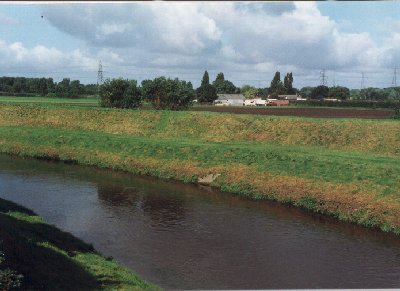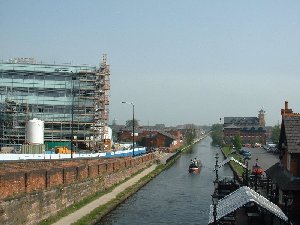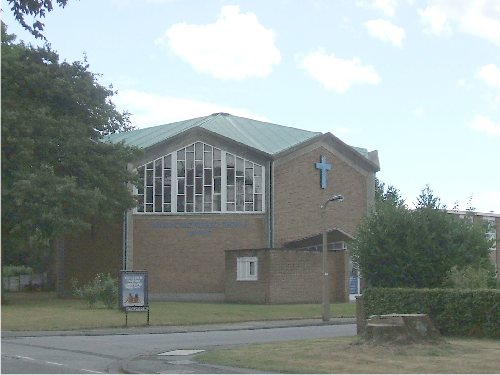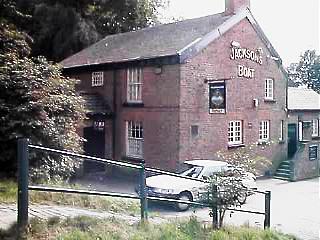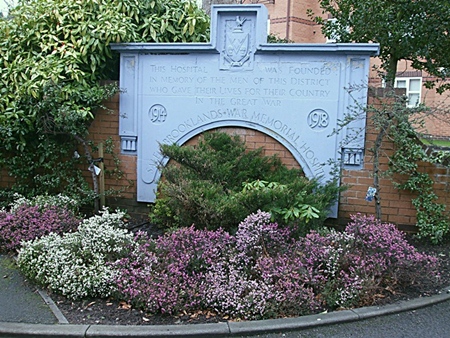On the preceding page, Sale, Cheshire, Part I are details of Sale's Location and History, with some suggestions for further
reading.
Landmarks and Sights
Although the town has few buildings of major historical or architectural importance, it does have a number of places of historical or geographical interest. The chief features of the town are its river, canal, main road and railway line, which are described below.
The River Mersey
Sale lies on the south bank of the River Mersey, whose origins lie some ten miles to the east, in Stockport. The river flows westward via the Manchester Ship Canal to the Irish Sea near Liverpool. The old Roman Road, today the A56 road between Manchester and Chester, crosses the River Mersey at Crossford Bridge. The river marks the former county boundary between Cheshire and Lancashire and today is still the boundary between Sale and, to the north, Stretford, both of which now are parts of the Metropolitan Borough of Trafford. Crossford Bridge is thought to
derive its name from a cross which stood on the Sale side of the Mersey at the site of the river-ford which preceded construction of the bridge.
The area near Crossford Bridge was notorious for flooding well into the 20th century but this is now avoided due to the creation of Sale Water Park (see below) and earlier remedial action, which included the construction of a dry weir as an overflow channel. The bridge was deliberately destroyed in 1745 to hinder the advance of Bonnie Prince Charlie, whose troops rebuilt the bridge and crossed towards Altrincham. A toll booth stood by the bridge from 1765 until the late nineteenth century.
Riverside paths are accessible at various places, including Crossford Bridge on the A56 and at Sale Water Park. Other crossings of the river include the former rail bridge, now used by
Metrolink trams, and the 1972 M60 (formerly M63) motorway viaduct which is part of the Manchester orbital motorway. This is being widened at Sale/Stretford (2003).
The Bridgewater Canal, built in 1765, crosses the Mersey on an aqueduct, constructed by James Brindley, just north of Dane Road Station. A ferry operated in the nineteenth century
across the Mersey, at Jackson's Boat Inn. In 1816 a footbridge was built at Jackson's Boat but that was destroyed in a storm. The current crossing is by means of an iron girder footbridge built in 1881 which allows quick access to Chorlton-cum-Hardy and south Manchester.
Bridgewater Canal
Built by the engineer, James Brindley, at the instigation of the Duke of Bridgewater, the canal runs the full length of Sale, more or less parallel to the railway (now tram) line and to the A56. It was built to transport coal from the Duke's Worsley mines to Manchester and crosses the River Mersey over Brindley's Barfoot Bridge (aqueduct) just over the border into Stretford. The Sale section was opened in 1765. Passenger packet boats operated from Sale to Manchester until the arrival of the railway in 1849. The Duke's heir, Lord Francis Egerton, had to be compensated when the railway arrived and at that time it was agreed that the former steam packet-boats from Runcorn to Manchester would terminate at Timperley, thereby obliging passengers to complete the journey by railway. By 1871 railway interests were influential in the operation of the canal and in 1897 the canal became part of the Manchester Ship Canal company. Today the Canal is much used by anglers and occasional leisure craft.
The Roman Watling Street
The A56 road runs in a stright line through Sale in a roughly north to south
direction. It is today named Cross Street, from the River Mersey to the
centre of Sale (School Road); from there to the Altrincham border it is named
Washway Road. The Roman road (Watling Stret) linked the forts of Deva (Chester) and Mamucium
(Manchester). Since 1974 the M60 (ex-M63) motorway has
crossed the A56, at junction 7, just over the Stretford border before crossing the Mersey
into Sale very close to the Water Park. Junction 6 is at Old Hall Road whilst junction 8 is the Carrington Spur, which links to Carrington Lane.
The Manchester South Junction and Altrincham Railway
The MSJA linked Sale to Manchester from 1849; its southern end is Altrincham. Today the electric trains have been replaced by Metrolink trams; the line was the first modern tram system to be installed in England, in 1992. For further details see below and the fine AERPS website.
Civic Buildings and Monuments: Sale
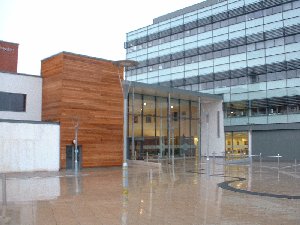
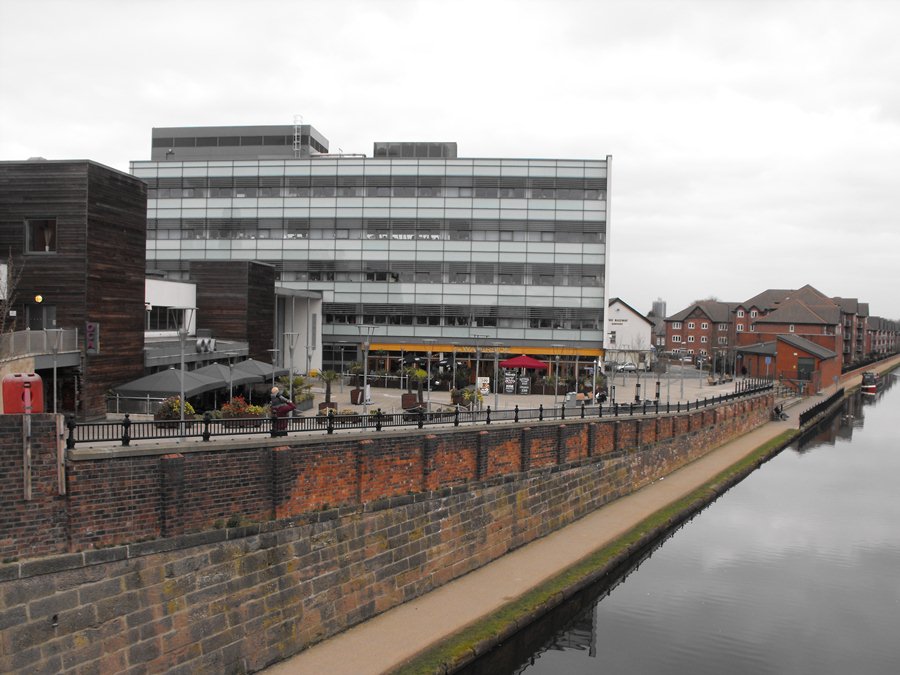
The new Sale Civic Centre, which opened in late 2003, and is now known as Sale Waterside.
Sale Town Hall
The Town Hall is situated at the top of School Road, almost opposite Sale station. Outside stands the Sale cenotaph (see below). The Town Hall is a regular venue for civil marriage services. It was opened in 1915, extended in 1939/40 and extended as Sale Civic Centre, incorporating the library/local studies centre and Robert Bolt Theatre (2003). Five months after the date on the opening plaque, the building was severely damaged by German bombing in December 1940. It was not fully repaired until 1952. As part of Trafford Metropolitan Borough, the town's affairs are now largely decided at Stretford Town Hall.
Sale Cenotaph
Designed by an Ashton-on-Mersey sculptor, A. Sherwood Edwards, the Sale memorial to the fallen of the two World Wars lies immediately in front of the Town Hall. Over 400 names
are listed as victims in World War I, whilst almost 300 of the town's citizens died in the Second World War, the vast majority on active service abroad. The memorial features
the image of St. George above panels which list the victims of the wars. They are listed on Carl's Cam. As well as the Town Hall, other Sale buildings damaged by German bombing in WWII were St Paul's Church, (Springfield Road), St Paul's Missionary Hall in Dargle Road and the Woolworth's store in School Road.
Robert Bolt Theatre
This new theatre (2003) replaced Sale Civic Theatre, which closed on the same site in 2002.
Sale Technical School
This mock-Tudor building, adjacent to the Public Library, was built in 1896. Since ceasing its educational function, it has served as an annexe to the Library.
Springfield Road School
Although it bears the date 1906, this infants' school opened in 1907. The ornamental brick work still denotes the separate entrances for boys and girls. Formerly, the
school stood on the opposite side of the road, on the corner with School Road.
Trafford Magistrates' Court
Opened by Princess Anne in November, 1985, the Trafford Magistrates' Courts stand opposite the
Bull's Head, at the junction of Ashton Lane and Cross Street.
Civic Buildings and Monuments: Ashton-on-Mersey
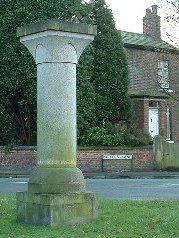
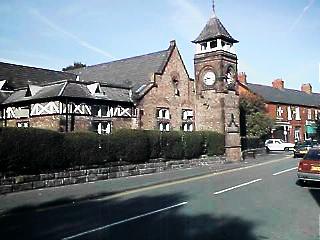
Ashton Fountain; The former St Martin's School, Ashton-on-Mersey.
Ashton Fountain
The sorry remains of the fountain, erected in 1881 at the junction of Moss Lane and Ashton Lane, now stand incongruously at the Barkers Lane side of the road rather then the middle of the road where they were originally located. This area used to be known as Newton Green and was formerly the site of the local gallows. The fountain was one of the many local benefactions of William Cunliffe Brooks, son of Samuel Brooks, the celebrated banker. Not only has the fountain been moved to a less prominent roadside position, over the years it has been deprived of
its top part, which used also to have a gaslight, and of its large horse drinking trough.
Brooks's Institute
Built in 1887 with a benefaction from the local banker, William Cunliffe Brooks, this mock Tudor building on Carrington Lane, Ashton-on-Mersey, serves as a community centre for meetings and as a polling station for elections. It was extended to the rear in 1953.
St Martin's School
The old school building, at the junction of Green and Carrington Lanes, was once the village school. The clock tower was erected in 1874 but the school itself originally dates from 1818 when the Earl of Stamford gave the land for its erection. Latterly, the premises have been used as studios for the recording of radio advertising jingles.
Private Residences
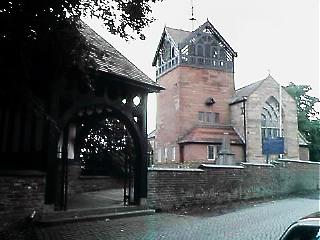
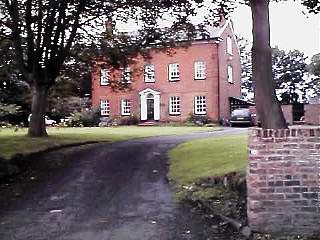
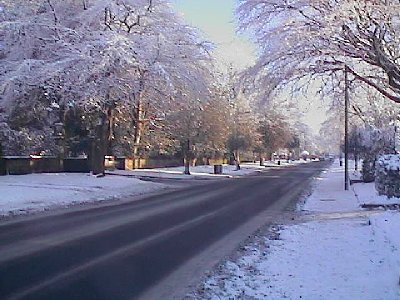

Left to right: St Martin's Church; Ashton New Hall; The Avenue on a snowy day (30/12/00), Oakleigh on The Avenue (2012)
Ashton New Hall
In Church Lane conservation area, Ashton-on-Mersey, is Ashton New Hall, built in 1804. It was originally occupied by William Williamson from Ashton Old Hall, which today comprises the premises of Old Hall Farm, which lies further down Church Lane.
The Avenue
One of the smartest addresses in Sale, this tree-lined, straight road, lies in the south-west of Sale. Formerly guarded by a gate house, which is now a private residence on the corner with Washway Road, The Avenue was originally built for Samuel Brooks, a local banker, and was known as Brooks's Avenue. Its largest house, Woodheys Grange, no longer exists; the Methodist Church is now more or less on the site of The Grange. Another sizeable house, 'Oakleigh', survives in good condition although other properties have been built in its grounds.In the latter part of the nineteenth century, the house was owned by the Lord family.
Eyebrow Cottage
The oldest building in Sale is Eyebrow Cottage, a yeoman farmhouse built c.1670 and one of the earliest brick buildings in the area. The name derives from the decorative eyebrow-like brickwork above the windows. The building stands next to the A56 in Cross Street, which at the time was a separate village from Sale. Today the building is in use as commercial premises.
Raglan House
Raglan House is a recently renovated Victorian house in Raglan Road, which was once the home of John Brogden, who won the contract to build the Manchester, South Junction and Altrincham Railway (1849) through Sale. Brogden became a millionaire through railways, whose construction he oversaw in Canada and Australia, as well as in Britain.
Sale Old Hall
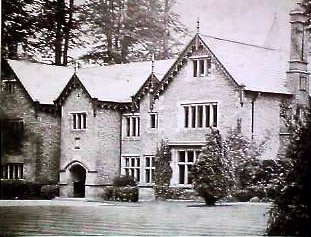
Sale Old Hall
The Old Hall no longer exists, its site now being largely occupied
by the M60 motorway near Sale Water Park. A rather sad reminder of the
existence of the Hall, which stood from at least 1577 and, possibly, had forerunners back to
the thirteenth century, is the old dovecote. In 1839 the house was bought
by Mrs Worthington, the benefactress of Sale (Worthington) Park. The Hall
was demolished in 1920. Today, the Hall's 1895 dovecote is now incongruously marooned in the middle of a roundabout next to
the M60 motorway embankment. Sale New Hall (1688) which for most of its life
was essentially a farm house, was located near the present-day New Hall Road
and its site is now covered by the M60 carriageway. The New Hall was demolished in 1953.
Sale Priory
This was not a priory in the religious sense but rather a substantial private
dwelling, which is no longer extant. Its gardens survive as parkland. The Priory was the home of Dr Charles White who accommodated the body of Hannah Beswick, whose morbid fear of being buried alive led to her being embalmed and kept at the Priory for a hundred years. Dr White died in 1913 but
his name survives in White's Bridge, at Dane Road, over the Bridgewater Canal.
Tyntesfield
Today this is the site of a primary school, but the original house was built
by the local banker Samuel Brooks. From 1850 it was owned by Fred Hardy, a
Manchester brewer, whose firm survives as an independent company today in Hulme, Manchester.
Woodheys Club
The Woodheys Club, a private social club, occupies the house formerly known as 'Woodheys', on the east side of the A56, between Sale Centre and the border with Altrincham.
At one time it housed Ernest Soares, a Manchester solicitor, who became Liberal MP for Barnstaple in Devon at the turn of the last century. The son of a Java-born merchant, he
was knighted in 1911. In the 1930s the premises operated as a private school.
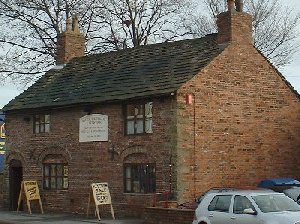
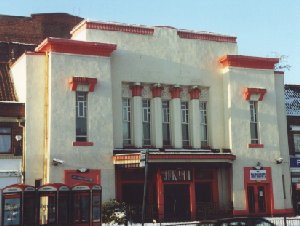
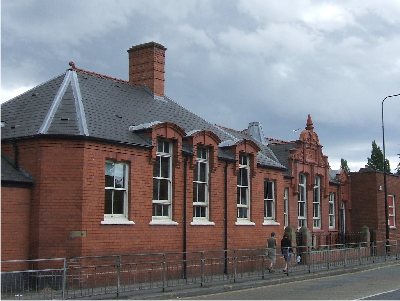
From left to right: Eyebrow Cottage on Cross Street (A56); The former Odeon
Cinema, on Washway Road (A56); Springfield Road School
Commercial Premises
The following are some of the town's more notable commercial premises. A
separate section on Public Houses is to be found below.
Former Odeon Cinema
Relaunched in 2002 as the L.A. Fitness Centre, (formerly JFK's nightclub), these premises originally opened as The Pyramid Cinema
in 1934, but later became the Odeon Cinema, which seated 2,000 people.
The style is the so-called Egyptian, beloved of cinema architects of the period.
Former Sale Lido
Nowadays a Mecca bingo club, these premises on Washway Road were for many years
the Sale Lido. This consisted of a 130ft long swimming pool which could
be covered over to make a ballroom. In the sixties, when known as the
Locarno Ballroom, it was a venue for emerging pop groups.
Lloyd's Bank
Built in 1902 on the sight of decorative gardens, the attractive sandstone building of Lloyd's Bank occupies a prime position opposite Sale
Town Hall, on the corner of School and Tatton Roads. The bank closed in 2000 and is now solicitors' premises
Churches
Most of Sale's churches were built in the wake of the population explosion which followed the arrival of the railway in Sale, in 1849.
St Anne's Church
St Anne's, opened on 17 July, 1854, is located just off Northenden Road.
It was the first of the major Victorian churches of Sale.
St John the Divine Church
This church, opened on 9 April 1868, stands on Brooklands Road.
St Joseph's Roman Catholic Church
Opened on 10 May, 1885, St Joseph's replaced an earlier RC chapel of 1866.
St Joseph's is a red-brick building on Hope Road, close to Sale Station.
It has an adjacent primary school.
St Martin's Church
The church of oldest origin (early 14th century) in Sale, it lies near the River Mersey, close to Ashton-on-Mersey village. The present building is eighteenth-century, but the tower is a late nienteenth-century addition. Its churchyard has many ancient graves and outside it is a set of stocks.
Situated at the junction of Harboro Road and Moss Lane, this striking church
was built, by public subscription, at a cost of £9,000, on land donated by
William Cunliffe Brooks. It opened on 29 March 1874, but did not become a parish
in its own right until 1896.
Located on Springfield Road and backing on to the Bridgewater Canal, this church, with seating for 700, was badly damaged by bombing in World War II. Opened in 1883 and consecrated the following year, the church is now fully restored and was cleaned of its urban grime in 1972.
Opened in 1856 on Park Road, its nearby burial ground contains remains
transferred from a former site at Jackson's Row, Manchester.
Opened on 30 September 1875, this neo-Classical building on Northenden
Road was sold for commercial purposes in 1980 but is still well-maintained.
Services are now held in the nearby former church hall.
Other Nineteenth-Century Churches
The Volunteer Hotel
This impressive public house, opened in 1898, and now the property of Holt's Brewery, stands on the site of an earlier pub, opened in 1807 as the White Lion. Its name derives from the Ashton-on-Mersey cum Sale Loyal Volunteers, a force raised to counter a threatened Napoleonic invasion of England in 1803. The Volunteers drilled on the nearby Sale Moor, to the east of the A56.
Recreation
Sale Water Park
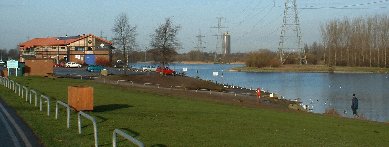
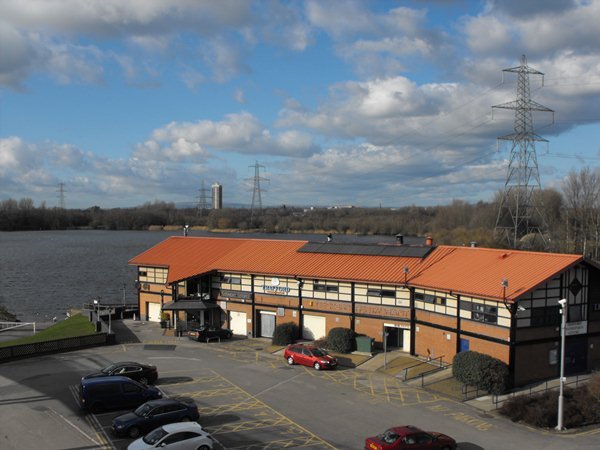
Sale Water Park.
One of the benefits of the motorway building programme, Sale Lake was created in 1972 by the excavation of 35 acres of gravel, to a depth of 30
metres to create the foundations for the adjacent M60 (formerly M63)
motorway, which opened in 1974. Today, the Water Park, which opened in
1980, occupies some 45 acres and provides facilities for
fishing, birdwatching, water-skiing and other watersports. The Park has a Visitor Centre and there
are regular Mersey Valley walks organised by its wardens. On the banks
of the lake is a restaurant and nearby is the Mersey Valley Visitor Centre.
Alongside the western side of the Park run the Bridgewater Canal and the Metrolink tram, between
Dane Road and Stretford stations. Along its northern edge is the
River Mersey. One unusual feature in the vicinity is
the dry weir, near Hawthorn Lane, built by William Cubbitt in
1841 as a diversionary route for Mersey flood water. Its purpose was
to protect the Barfoot aqueduct over the Mersey which carries the Bridgewater
Canal. The weir has not be needed since 1915.
Sale (Worthington) Park
Located five minutes from Sale Station, this park was opened on 30 June, 1900.
It takes its name from Mrs Worthington, of Sale Lodge, whose money created the
park. It occupies 16.5 acres and when opened boasted a bandstand and ornamental
lake. The base part of the bandstand remains. A large stone lion which adorned the Park for decades can still be seen
in Sale Children's Library, where it is now kept to protect it from vandalism.
Walton Park
Walton Park is situated adjacent to the Bridgewater Canal, near Brooklands station. It
offers tennis, putting, crown-green bowling and children's playgrounds. A
miniature railway runs on Sundays. There is also the Trafford Rowing Club
boathouse here, located on the site of a former grain store serviced from
the adjacent canal. The University of Manchester also has a rowing
club house further north from Walton Park, near Dane Road Station.
Ashton Park
Ashton Park lies between Grosvenor Road and Glebelands Road in Ashton-on-Mersey.
It offers bowling and football facilities, as well as a children's
playground.
Sale Leisure Centre
Built on Broad Road in the early 1970s on the site of Sale Baths, it
provides a wide range of facilities including two swimming pools, gymnasia
and table-tennis.
Sport
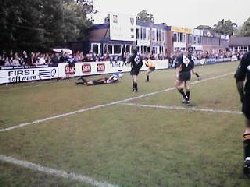
Before the days of Sale Sharks, Sale RUFC score a try against Wasps, 8 May, 1999, but lose 13-27.
Sale is only three miles from Old Trafford, the home of both the Lancashire
County Cricket Club and of Manchester United Football Club. The City of Manchester stadium, the home of Manchester City FC is also within 10 miles of Sale. Closer by is Moss Lane, the ground of Altrincham Football Club who play in the Unibond
Premier League.
Trafford Football Club plays at Shawe View, near Chassen Road Station, in Flixton, whilst Flixton FC play at Valley Road. Amateur football leagues are active in the
area and some teams, such as Jackson's Boat FC, have grounds in pleasant surroundings.
In Altrincham, ice hockey was played at the Altrincham Ice Rink in Devonshire Road, built by local businessman Albert Allen (died 2002), who also owned Altrincham's Cresta Court Hotel but this closed in 2003 and was replaced by the Silver Blades "9ce dome" off Moss Lane, Altrincham where the Manchester Phoenix ice-hockey team is based.
Founded in 1861, Sale (Rugby) Football Club's ground is to be found on Heywood Road, near Brooklands Station. Amateur rugby still takes place here. Now separate and owned by Cheshire Sports, the professional version of the game is played by Sale Sharks, who play at Edgeley Park, Stockport.
Sale Sports Club in Clarendon Crescent incorporates Sale Cricket Club, Sale Hockey Club and Sale Lawn Tennis Club. Ashton-on-Mersey Rugby Club
is close to the Mersey off Church Lane. Sale Cricket Club has grounds on Dane Road, whilst Brooklands also has a flourishing cricket club. The Sale Cricket Club
can claim the honour of having set up the Sale Football Club.
Sale United FC play at Crossford Bridge, adjacent to the former HQ of the well-known Sale Harriers athletic club. The Harriers now have their base outside the town limits and at one point styled themselves Sale Manchester Harriers. The Harriers were reformed
in 1911 after an earlier grouping in the 1890s had foundered.
Ashton-on-Mersey Golf Club (1897) is to be found off Church Lane on a site which was formerly part of Ashton
Old Hall's lands. Sale Golf Club was founded in 1913, also on the banks of the Mersey, off Old Hall Road. The club house of Sale Golf Club is the former
Sale Lodge, a fine building of 1830, constructed for a Lancashire merchant, Edmund Howarth.
On the Bridgewater Canal between Brooklands and Sale are the moorings of the Sale Cruising Club.
Culture
The long-established Sale Operatic Society, which has recently renamed itself Sale and Altrincham Musical Theatre has a Web site. On the dramatic front, the local theatrical troupe
is the Sale Nomads.
Transport
Rail Transport
Sale has three former railway stations, all of which now function as unstaffed and rather sad Metrolink tram stations. The line through Sale is a straight line from Dane Road to the Altrincham border, at Timperley, and it runs parallel to the Bridgewater Canal throughout. All three stations in Sale sit on bridges which span both the railway and the Canal. These stations are, from north to south, Dane Road (opened 20 July, 1931),
Sale (opened 20 July 1849) and Brooklands (opened 1 December, 1859). A further station was planned, to the south, near the foot of Eastway, but this was never built. Work
on Sale Station's current building began in 1874.
The original steam line was electrified in 1931 but today no British Rail services operate on the line, except on a short parallel section near
Altrincham station. Until the arrival of Metrolink, in 1992, local services ran through Manchester to such destinations
as Crewe, Alderley Edge and Styal. Metrolink Trams run in rush hours at approximately six-minute frequencies
and generally north-bound services alternate between Bury and Manchester
Piccadilly as their destination. All south-bound services go to
Altrincham apart from the occasional short-working to Timperley.
The route is entirely along former railway lines except for street tracks
in the city centre. Metrolink's policy of having unstaffed stations
means that the facilities have fallen prey to vandalism and roosting pigeons and their failure to publish detailed timetables is an annoyance to pasengers. The service, which with appropriate investment and an integrated ticket system could be excellent, also suffers from insufficient rolling stock, with rush hour trams overcrowded. To the south, the line runs to Altrincham, where there is an hourly rail service to Chester, Stockport and Manchester.
Buses and Coaches
The electric tram reached Sale in 1906, but did not get to Sale Moor until 1912. The motor bus arrived in 1931. Today, the convenience of bus
services in Sale centre is adversely affected by the absence of a bus station or central stop, particularly for south-bound services
to Altrincham. This inconvenience is compounded by the diversity of operators
arising from bus deregulation which make individual bus company passes of limited value. The main bodies operating services are the national
companies, Arriva and Stagecoach Manchester., with Go Goodwins dominating local services within Sale. The Manchester firm of Finglands also has a presence on evening and weekend services.
Services to Altrincham from Sale (16,18,19,41,245,263,264) run from a variety of bus-stops on Cross Street/Washway Road and from Hayfield Street/Sibson Road. Sadly, Sale has now central bus station so you have to commit to one route or another. Services to Manchester run from stops on Cross Street/Washway Road. Some of these services also serve the Racecourse (Sale West) Estate (16,17,19), others operate via Sale Moor (18,19). Services also run to Partington (252) and Manchester Airport (19), whilst service 18 runs to the Trafford Centre
at Dumplington. Many further connections into Cheshire can be made from Altrincham bus interchange. A once a day National Express coach service to London calls in Sale, using the bus stop at School Road.
Copyright: ©
Contact: the following is not a link; please transcribe the address into your email 

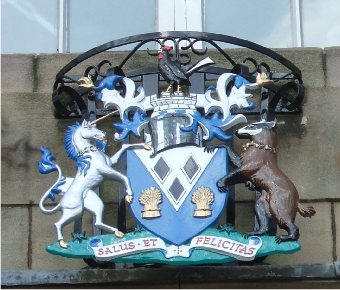

 24 March 2012
24 March 2012
